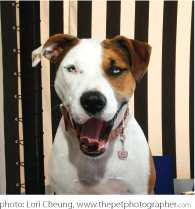| |
|

Jasmine Blue's Tails of the Dog Park
Chapter 17: The pitfalls of breedism
By Susan Dyer Reynolds
 All those dogs should be killed!” the old man with two yapping Yorkies said loudly in the middle of Pet Food Express. Jasmine Blue, then six months old, was standing beside me, head cocking from side to side at the piercing “yip, yip, yip” of the man’s tiny dogs, each clad in tiny Burberry coats. All those dogs should be killed!” the old man with two yapping Yorkies said loudly in the middle of Pet Food Express. Jasmine Blue, then six months old, was standing beside me, head cocking from side to side at the piercing “yip, yip, yip” of the man’s tiny dogs, each clad in tiny Burberry coats.
I kept my cool. “What dogs?” I asked. “Tri-colored dogs? Piebald dogs? Blue-eyed dogs?” The old man shook his head vigorously and pointed at Jasmine, “No! THOSE dogs!”
Truth be told, I’m not a huge fan of yappy little dogs, but I would never say that to a yappy little dog owner. Few people ever say anything about another person’s dog other than small talk (“Oh, what a cute puppy!”). But when you have a pit bull, the strangest thing happens – people feel it’s their right to say things – really awful things – to your face.
Since I adopted Jazzy just two and a half years ago, I’ve had a lot of strange encounters. Some people are irate like the old man with the yappy Yorkies; others mask their fear with nervous attempts at humor. A woman once approached me in the dog park and asked, “Is she going to eat me?” “Well,” I said, looking at my watch, “she had a toddler for breakfast, so I think you’re safe.”
Others are openly fearful, crossing the street to avoid us or picking up their children. One woman grabbed her son and turned to her husband, who was walking their Boston terrier. “Pick up the dog, honey,” she said, “That’s a pit bull.”
What the woman obviously didn’t know was that Boston terriers were bred down from pit fighting stock. In the mid-1800s in Boston, they were divided as light, middle and heavyweight, with the largest tipping the scales at nearly 45 pounds. My grandmother actually raised Bostons in Rhode Island, and my memories are of tough, smart dogs that didn’t like kids very much. My aunt’s pit bulls, on the other hand, loved to follow me down the beach while I was clamming with my cousins, and later take a long snooze in the sunroom with their heads, which weighed as much as honeydew melons, across my legs; their bodies pressed as close as possible to me, even on a hot summer’s day.
Over the years, a number of breeds, including Rottweilers, German shepherds and Doberman pinschers, have taken their turns being demonized and vilified, usually starting with the media. When Diane Whipple was tragically mauled to death in 2001, members of the press initially misidentified the dogs involved as pit bulls, when in reality they were Presa Canarios. While advocacy groups and a few members of the media such as myself have tried to set the record straight, it is amazing how many people still approach me and say, “Pit bulls killed Diane Whipple.”
There have certainly been incidents of aggression toward humans involving pit bulls, and of the 144 fatalities between 2000 and 2005, 41 were caused by pit bulls, pit mixes, or dogs that law enforcement deemed “pit bull-like.” But experts say that because “pit bull” is not a breed but rather a term used to describe dogs similar in appearance to American pit bull terriers or American Staffordshire terriers, mistaken identity is frequent, and consequently numbers are inflated. Other large breeds, including Rottweilers, accounted for some of the fatalities, and Labrador retrievers, thought of as mild-mannered, were responsible for six of the deaths. While large dogs were implicated in the majority of human fatalities, they did not account for all of them: In 2000, a Pomeranian killed a six-week-old girl, but those stories don’t usually make the evening news. Pit bulls – with their huge jaws, muscular builds, and reputation as the breed of choice for dog fighting – make much better headlines.
To put all of this into perspective, there were over 20 million dog bites between 2000 and 2005 that did not result in death. More than half the victims were children; nearly 80 percent of cases involved a dog the victim knew. The Insurance Information Network of California says that those bites accounted for one-fourth of all liability claims on homeowners’ insurance policies, and they also say that “owner responsibility” is key to avoiding potential incidents.
Without a doubt, in every single case of fatality, the owner of the dog is responsible either directly or indirectly. In the case of Diane Whipple, owner Marjorie Knoller was accused of encouraging the attack and was later convicted of second-degree murder. There are no mean puppies, just puppies that grow up mistreated by mean humans. There are no bad dogs, just bad dog owners.
When I adopted Jazzy, I hesitated about whether to tell my long-time State Farm insurance agent, Kate McIntyre, that I had a pit bull, because many agencies will not insure certain breeds. One day, while visiting her office for other business, I casually asked about State Farm’s dog policy. “We ask two questions,” Kate explained. “Whether the dog has ever bitten anyone, and whether it has been trained for guard or attack purposes.” It turns out State Farm is not breedist – unlike Allstate, for example, which has a long list of breeds they won’t insure, including pit bulls, boxers, chows, Dobermans, Rottweilers, and Akitas. In 16 years as a State Farm agent, Kate says she has had only two dog bite claims – neither was serious and neither involved any of the breeds Allstate and many other agencies refuse to insure.
Still, the media hysteria over pit bulls has led to many misconceptions. “I’m afraid of pit bulls,” one little boy explained as he peered over the dog park fence at Jazzy, “because their jaws lock.” When I told him that the only animal with locking jaws is the crocodile, he seemed relieved. Jazzy licked the palm of his hand through the gate and wagged her butt. The boy giggled. “She loves kids,” I said, and he cautiously came through the gate. As she always does with children, Jazzy approached slowly, never jumping up. She licked his nose and he laughed some more, picking up a tennis ball he spotted a few feet away. Jazzy is not big on fetch (she’s a pit bull, not a golden retriever), but when the boy threw the ball she eagerly chased it as if it were her favorite game. The boy, however, decided it would be more fun if they both chased the ball. Jazzy got to it first and began to run around the park, the laughing boy chasing after her. At last he caught her and asked her to drop it. She did. He threw it again, and again they both gave chase. This time the boy beat the dog (she’s a pit bull, not a greyhound); he picked up the ball and began to run around the park, the happy dog chasing after him. This went on for nearly half an hour – the boy chasing the dog, the dog chasing the boy – until Jazzy flopped in the shade of a tree and the boy flopped beside her. “Do you come here every Saturday?” he asked, stroking Jazzy’s soft ears. “Mostly,” I told him. For weeks, the boy showed up, and the two would engage in their ritual. When I found out Jazzy needed knee surgery I let him know that she wouldn’t be back to the park for quite some time. As he sat next to her under the tree stroking her soft ears, he began to cry. “I’ll miss her,” he said quietly, and buried his face in her fur. As she did with me after my father’s death, Jazzy licked the tears from his cheeks until he started to laugh, which made her lick him all the more.
Society has a long history of blaming the breed and not the deed. Pit bulls are now banned in more than 200 cities, including Pawtucket, Rhode Island, where I spent those lazy summers clamming and napping with my aunt’s dogs. Breed-specific legislation, or BSL, has been proven ineffective. Donna Reynolds, who cofounded the organization BAD RAP (Bay Area Doglovers Responsible About Pit Bulls), says that in Florida, where pit bulls have been banned for a decade, there are now more pit bulls than ever. After the United Kingdom banned pit bulls in the 1990s, a study showed the number of dog bites remained the same even though the number of pit bulls sharply declined. In 2005, the Dutch government lifted a 25-year ban on pit bulls because it did not lead to any decrease in bite incidents. Instead, the country now focuses on enforcing leash laws, owner education programs, and expert temperament testing of dogs that have displayed aggression. And despite the fact that most insurance companies won’t insure breeds they deem “high risk,” dog-bite claims remain one-fourth of all homeowners’ claims.
“Dog Whisperer” Cesar Millan, who has done much to improve the reputation of pit bulls with his laid back sidekick, Daddy, says that breed bans fail because they don’t get rid of the real problem – untrained owners: “I have Harvard graduates for clients who can’t control a Chihuahua.”
Granted, death by Chihuahua is not likely, but getting bitten by one is: In a 2008 study from the Center for the Interaction of Animals and Society at the University of Pennsylvania that analyzed the behavior of thousands of dogs, they ranked second of 33 breeds rated for aggression, followed by Jack Russell terriers. The number one biter: dachshunds. One in five wiener dogs has bitten or snapped at a stranger, nearly as many have attacked other dogs, and one in 12 has gone after its owner. Interesting, because the only dog that ever bit me was a dachshund. When I was 8 years old, my father and I were waiting in the veterinarian’s office for our pit mix, Chipper, to get his yearly exam. For some reason I decided to run across the room, upon which a dachshund leapt from the lap of its owner and bit me in the behind. It didn’t kill me, but it hurt like hell, and for weeks I had a teeth mark-shaped bruise.
Jasmine Blue, on the other hand, has never bitten a stranger or me, yet nearly every time we go for a walk we get dirty looks, shaking heads, and nasty comments. The saddest moments are when Jazzy wags her butt up to someone with a huge pittie smile hoping for a pat on the head, but the person instead recoils in disgust. While she may not know the full extent of the gesture, she is sensitive enough to know there’s something wrong; sometimes she even looks slightly embarrassed by the rejection. Fortunately, unlike humans, she doesn’t know they think there’s something wrong with her just because of the way she looks.
The same things responsible for human prejudice are responsible for breedism – fear, misinformation, stereotyping, and ignorance. Maybe the next time you see a dachshund, you’ll steer clear. Better yet, next time you see a pit bull wagging its butt toward you with a big pittie smile, maybe you’ll offer a pat on the head.
E-mail: Jasmine@northsidesf.com



|
|
|
|







